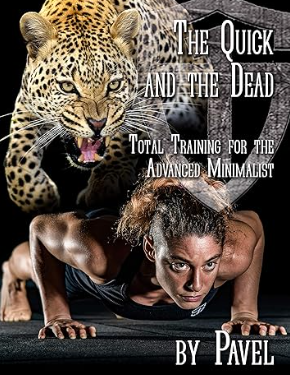
I mentioned previously that I’ve been following Dr. Peter Attia’s suggested aerobic exercise protocol for longevity. The part of the protocol I’ve least enjoyed is the 4×4 intervals for maximum aerobic intensity, because they lead to soreness the next day.
Recently I read The Quick and The Dead by Pavel Tsatsouline, which offers an intriguing alternative. It gets into some exercise science to explain the rationale, which I’ll get to below for those interested. The bottom line is that you do sprints, about 20 seconds long, of your activity of choice, with a lot of easy recovery time in between (more than 5 minutes). I have tried this and the sprints are challenging and it feels great. And very little soreness afterwards. For biking I just cruise along in a brisk aerobic pace. Then I do a 20 second sprint as hard as I can, followed by a but over 5 minutes of brisk cruising. I repeat this sprint/cruise 10 times, and finish with a cooldown. For my upper body, I do my normal strength training with resistance bands. Then I do the alternating sprint/cruise arm cycling. I also alternate sprinting/cruising on my kayak simulator with weight bands. So far I’m up to 5 repeats with the arm cycling and 4 with the kayak simulator. I’ll report back in a few weeks how this is working out full time.
I have found Pavel’s writing fascinating for some time. He is most famous for introducing Westerners to the kettlebell, but also has brought over a lot of lost exercise science knowledge from the former Soviet Union. Until now I have not actually followed any of his advice to the letter so I’ll be interested to see how this works out. I must admit I’m still not exactly following the book’s advice, because the book recommends specific exercises like kettlebell swings but I’ve adapted it to cycling and arm-cycling.
Exercise Science Behind Sprints With Longer Recovery
The point of high intensity exercise like the 4×4 intervals or Pavel’s sprint/full recovery approach is to fully develop the aerobic capacity of our fast twitch muscles. These muscles come in two types, fast-oxidative, and fast-glycolytic. The former can be trained to develop their mitochondrial capacity and thereby improve their aerobic capacity. This is good for both performance and health. The conventional wisdom is to do this by exercising for a significant time at a high intensity, like the 4×4 intervals. Everything up to this point is exercise science 101. But Pavel present’s an alternative mechanism I’d never heard of which is activated by the sprints: The standard way our muscles are provided with energy to do aerobic work is to break the molecule adenine-tri-phosphate (ATP) molecule to adenine-di-phosphate. But it turns out if you hold a sprint for long enough (like more than about 10 seconds but no more than about 20), there is an “emergency mechanism” that can be called upon: adenine-di-phosphate can break down to adenine-mono-phosphate, yielding more energy. The catch is that it takes a while to recover from this, which is why the recovery periods between sprints of over five minutes are needed. But this trade-off is more than worth it in the wild: a leopard sprinting to catch an antelope doesn’t mind if it has to go slowly for a while afterwards. An antelope that has just escaped a leopard doesn’t mind hiding and resting for a while either. This is where the title of the book “The Quick and The Dead” come from.
Here’s the cool part from a health standpoint: I’ve heard the AMP-activated protein kinase (AMPK) molecule mentioned in various places as a potent stimulus for improving mitochondrial status in muscles. But I didn’t realize up till now that the “AMP” in AMPK is precisely adenine-mono-phosphate. What the body senses is a relatively low levels of ATP compared to levels of AMP. This is what occurs in muscles when you do the repeat bouts of 20 second sprints, and is why this is a potent alternative mechanism to high-intensity interval training. And as I’ve mentioned, it is touted as leading to less soreness, which I have found to be true for me.
Published by BionicOldGuy
I am a Mechanical Engineer born in 1953, Ph. D, Stanford, 1980. I have been active in the mechanical CAE field for decades. I also have a lifelong interest in outdoor activities and fitness. I have had both hips replaced and a heart valve replacement due to a genetic condition. This blog chronicles my adventures in staying active despite these bumps in the road. View all posts by BionicOldGuy
Published





